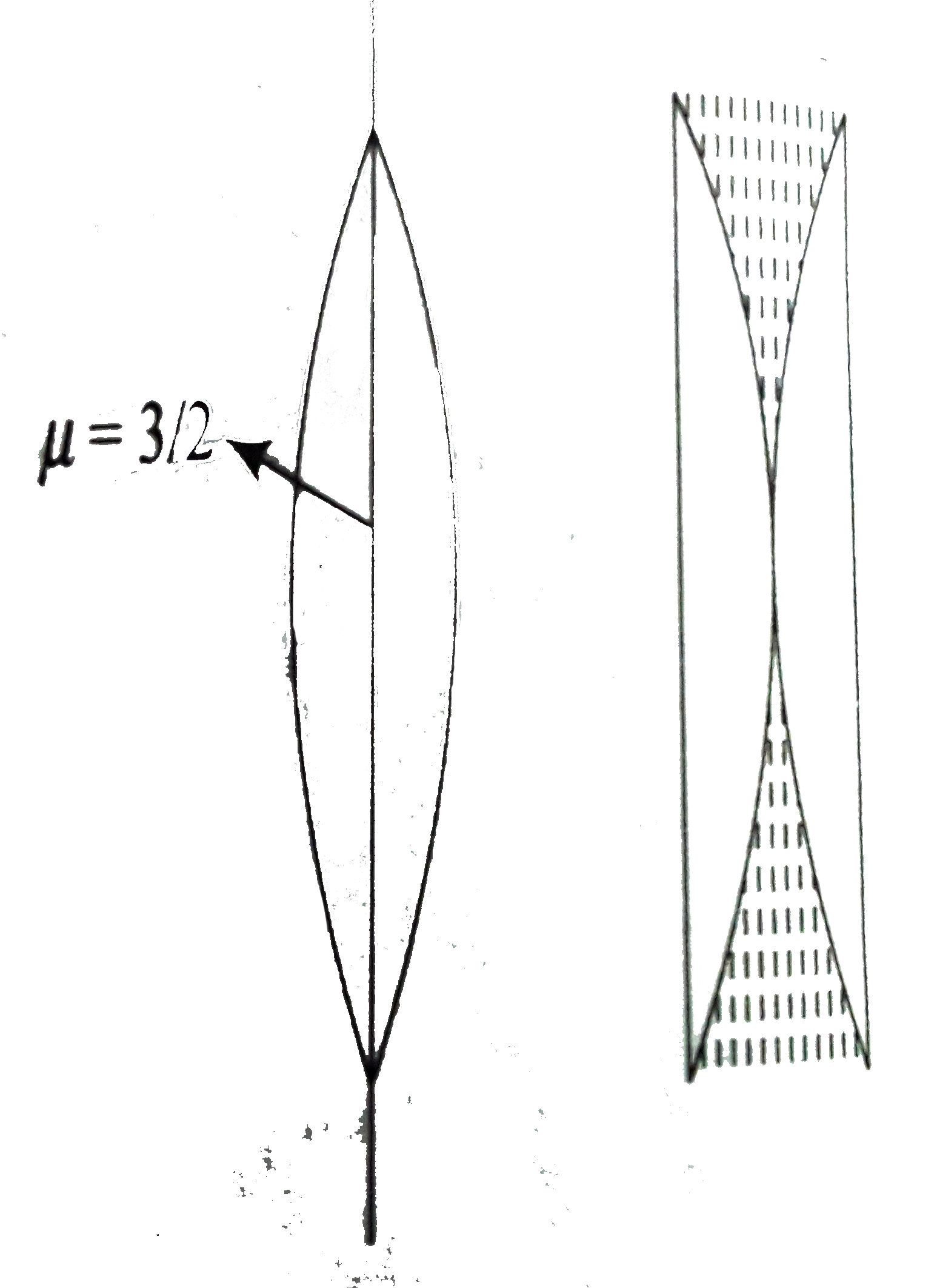Two identical glass (μg=3/2) equiconvex lenses of focal length f are kept ini contact. The space between the two lenses is filled with water (μw=4/3). The focal length of the combination is
The correct Answer is:D
To find the focal length of the combination of two identical equiconvex lenses in contact, with the space between them filled with water, we can follow these steps:
Step 1: Understand the System
We have two identical equiconvex lenses made of glass with a refractive index μg=32 and focal length f. The space between the lenses is filled with water, which has a refractive index μw=43.
Step 2: Focal Length of Each Lens
For a single lens, the formula for the focal length f is given by:
1f=(μ−1)(1R1−1R2)
For an equiconvex lens, we have:
- R1=R (positive for the first surface)
- R2=−R (negative for the second surface)
Thus, the equation becomes:
1f=(32−1)(1R−(−1R))
1f=(12)(2R)=1R
This implies:
R=f
Step 3: Focal Length of the Water Layer
Now, we consider the water layer between the two lenses. The effective focal length f′ of the water layer can be calculated using the same lens formula:
1f′=(μw−1)(1R1−1R2)
Here, since the water behaves like an equiconcave lens:
- R1=R (positive)
- R2=−R (negative)
Thus, the equation becomes:
1f′=(43−1)(1R−(−1R))
1f′=(13)(2R)=23R
Step 4: Combine the Focal Lengths
Now, we need to find the total focal length F of the combination of the two lenses and the water layer. The formula for the combination of lenses in contact is:
1F=1f+1f′
Substituting the values we found:
1F=1f+32⋅23f=1f+23f
Finding a common denominator:
1F=33f+23f=53f
Thus, the total focal length F is:
F=3f5
Final Answer
The focal length of the combination is:
F=3f5
We have two identical equiconvex lenses made of glass with a refractive index μg=32 and focal length f. The space between the lenses is filled with water, which has a refractive index μw=43.
For a single lens, the formula for the focal length f is given by:
1f=(μ−1)(1R1−1R2)
For an equiconvex lens, we have:
- R1=R (positive for the first surface)
- R2=−R (negative for the second surface)
1f=(32−1)(1R−(−1R))
1f=(12)(2R)=1R
This implies:
R=f
Now, we consider the water layer between the two lenses. The effective focal length f′ of the water layer can be calculated using the same lens formula:
1f′=(μw−1)(1R1−1R2)
Here, since the water behaves like an equiconcave lens:
- R1=R (positive)
- R2=−R (negative)
1f′=(43−1)(1R−(−1R))
1f′=(13)(2R)=23R
Now, we need to find the total focal length F of the combination of the two lenses and the water layer. The formula for the combination of lenses in contact is:
1F=1f+1f′
Substituting the values we found:
1F=1f+32⋅23f=1f+23f
Finding a common denominator:
1F=33f+23f=53f
Thus, the total focal length F is:
F=3f5
The focal length of the combination is:
F=3f5
Topper's Solved these Questions
- RAY OPTICSBOOK - DC PANDEY ENGLISHCHAPTER - RAY OPTICSEXERCISE - A. Only one option is correct (JEE Advance)
73 Videos
- RAY OPTICSBOOK - DC PANDEY ENGLISHCHAPTER - RAY OPTICSEXERCISE - B. More than one option is correct
20 Videos
- PROPERTIES OF MATTERBOOK - DC PANDEY ENGLISHCHAPTER - PROPERTIES OF MATTEREXERCISE - Integer
8 Videos
- ROTATIONBOOK - DC PANDEY ENGLISHCHAPTER - ROTATIONEXERCISE - (C) Chapter Exercises
39 Videos
Similar Questions
Two identical glass (μg=3/2) equi- convex lenses of focal length f each are kept in contact. The space between the two lenses is also filled with water (μg=4/3). The focal length of the combination is
View SolutionTwo identical glass (μg=3/2) equi- convex lenses of focal length f each are kept in contact. The space between the two lenses aiisolfilled with water (μg=4/3). The focal length of the combination is
View Solution
Knowledge Check
Two identical glass (μg=3/2) equiconvex lenses of focal length f are kept in contact. The space between the two lenses is filled with water (μw=4/3) . The focal length of the combination is
AfBf2C4f3D3f4
Two concave lenses L1andL2 are kept in contact with each other. If the space between the two lenses is filled with a material of smaller refractive index, the magnitude of the focal length of the combination
View SolutionTwo lenses of power 15D and -3D are placed in contact. The focal length of the combination is a
View SolutionTwo thin lenses of focal lengths f1 and f2 are in contact. The focal length of this combination is
View SolutionA concave mirror of focal length f (in air) is immersed in water (μ=4/3). The focal length of the mirror in water will be
View SolutionTwo lenses of power −15D and +5D are in contact with each other. The focal length of the combination is
View SolutionA convex lens of focal length f1 is kept in contact with a concave lens of focal length f2. Find the focal length of the combination.
View SolutionA thin equiconvex lens (μ=3/2) of focal length 10cm is cut and separated and a material of refractive index 3 is filled between them. What is the focal length of the combination?

View Solution
